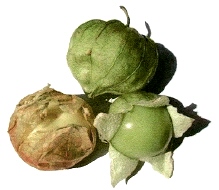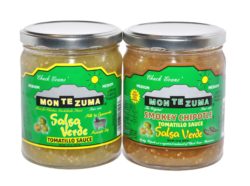 Never leaving its native home, the tomatillo [toh-MAH-tee-YO] or little green husk tomato is very important in the cooking of Mexico and to a lesser extent in Guatemala and Belize. The tart green fruit of the nightshade (Solanaceae) family is also called tomate verde, miltomate, tomate de cascara, and fresadilla. The fruits are between 1″-2″ wide and have a papery outer skin or husk. The tomatillo is used while still green in many salsas and moles.
Never leaving its native home, the tomatillo [toh-MAH-tee-YO] or little green husk tomato is very important in the cooking of Mexico and to a lesser extent in Guatemala and Belize. The tart green fruit of the nightshade (Solanaceae) family is also called tomate verde, miltomate, tomate de cascara, and fresadilla. The fruits are between 1″-2″ wide and have a papery outer skin or husk. The tomatillo is used while still green in many salsas and moles.
Deriving from Nahuatl, where the Aztec language operates by adding prefixes and suffixes to root words, several genera of tomatl were described as round and plump fruit. Confusion arose in translating, therefore distinguishing in the early written records the different tomatl, including the domesticated miltomatl, or green husk tomato, from the plump red fruit we know as the tomato (or tomate in Spanish) which derived from the Nahuah word xitomatl.
Presently, in many areas of Mexico, domesticated tomatillos are called tomates; the wild varieties are called miltomates; and what we know as tomatoes are called jitomates. Conquered indigenous tribes under Aztec governance provided tribute to their captors. In pre-conquest Aztec tribute lists, tomatls are mentioned, although confusion exists as to whether they are miltomatl or xitomatl or possibly both. Around A.D. 1550, Don Juan de Guzman, the Governor of Coyoacàn in the Valley of Mexico (known as Anahuac Lands of Water & todays Mexico City) has a list showing the receipt of 700 chiles and 700 tomates a week. Presumably these tribute tomatoes were the highland tomatillo. Don Juan’s tribute lists illustrate the consistent link between chiles and tomatoes.
The tomatillo, from the genus Physalis philasdelphica, is a relative of the fruit we know as the tomato from the genus Solanum lycopersicon. These relatives occupy different ecological niches in Mesoamerica. The tomatillo/miltomate grows abundantly in the highlands whereas the tomato/jitomate grows successfully in the humid lowland areas.
Evidence of miltomatl tissue has been dated as far back as ca. 800 B.C. and found in Tehuacan cave levels (south of the ciudad de Puebla) dating to A.D. 825-1225. The Europeans and especially the Italians, eventually accepted (although somewhat hesitatingly) the lowland Solanum, which thrived in Mediterranean conditions. The highland Physalis was never accepted by the Europeans and essentially never left its native shores until recently. However, the tomatillo has migrated north with legal and illegal Mexicans into the USA and remains a staple in their diet.



